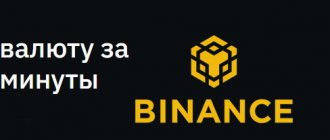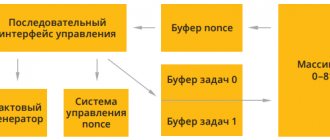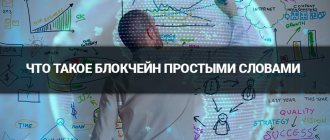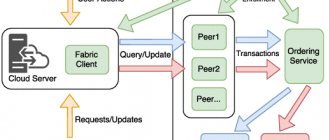How we develop software products
How we transferred Exonum from Iron to actix-web
When creating our private blockchain development platform Exonum, we used the Iron web framework. However, over time, its authors stopped releasing updates and it became outdated. actix-web was chosen as a replacement for Iron. In this article, we share our experience of migrating Exonum to a new framework using generalized programming techniques: we will provide the code “before” and “after” updating the entire backend.
A look at Tokio: how an asynchronous event handler works
Another article about the development of our Exonum framework. We talk about how we implemented the Tokio asynchronous event handler to replace the Mio library. We provide code and diagrams for implementing event loops for working with Exonum blockchain nodes, and also talk about the functional components of Tokio - futures and streams.
First binding for Exonum: why we chose Java
Exonum is written in Rust, as this language is focused on memory safety (which is important when creating blockchains). However, Rust is a rather difficult language to learn. To make working with the Exonum platform easier for users, we wrote a binding library in Java. In the article we tell you why we chose Java and provide guidance on creating Exonum services in the “new” language.
How to deanonymize Bitcoin blockchain users and why it is necessary
Blockchain is an anonymous network in which the identities of address owners are unknown.
Cybercriminals use this to withdraw funds obtained illegally (for example, using ransomware viruses like WannaCry). However, it is still possible to determine the owner of a particular wallet on the Bitcoin network. To do this, we have developed a special clustering method that combines addresses belonging to the same owner. Searching for information in various sources, manual registration on exchanges and other methods make it possible to determine the owners of the resulting clusters. In this article, we described how our approach works, compared it with similar methods, and shared test results.
Monitor for Lightning Network from the Lightning Peach team
Last September, our Lightning Peach developers introduced a monitoring system for Lightning Network nodes - LN Monitor. It tracks the number of connected nodes in the network, the average lifetime of established bidirectional channels, commission rates, and much more. In the article we analyze the capabilities of the tool using real LN data - with graphs and explanations.
#BitFury
BitFury is a company engaged in mining and production of mining equipment. Released a 16nm ASIC chip that features revolutionary high performance. In order to popularize cryptocurrencies, Bitfury has developed a Bitcoin light bulb miner. It is one of the largest companies operating in the field of cryptocurrency.
Bitfury CEO joined the board of directors of crypto broker Voyager
Cryptocurrency broker Voyager Digital has included the CEO of Bitfury Group and former CEO of the American exchange Binance.US Brian Brooks on its board of directors.
Lena Jess 309 12/21/2021
Bitfury confirms appointment of Brian Brooks as CEO
Leading technology solutions provider Bitfury Group has confirmed that the position of CEO of the company has been taken by the former head of the Office of the Comptroller of the Currency (OCC) of the US Treasury Department and the American branch of the Binance exchange, Brian Brooks.
ForkLog 504 05.11.2021
Journalists reported on Bitfury's plans to go public
Leading technology solutions provider Bitfury Group plans to go public, The Telegraph writes.
ForkLog 562 10/11/2021
Bitfury has calculated the number of ASIC miners from China that will not return to the network
How the ban on cryptocurrency mining in China affected the global mining market and how many devices will not return to the network, Vadim Krutov, executive director of the Bitfury Group, told ForkLog.
Lena Jess 5290 07/20/2021
A US mining company intends to go public with a valuation of $2 billion.
Cipher Mining Technologies Inc, the newly formed US mining subsidiary of Bitfury Top HoldCo BV, has entered into a definitive agreement to merge with Nasdaq-listed special purpose acquisition company (SPAC) firm Good Works Acquisition Corp.
Roman Petrov 3867 03/07/2021
Bitfury has decided on the construction site of the Ukrainian data center at the nuclear power plant
A data center from the Bitfury Group and Energoatom using the capacities of the Ukrainian nuclear power plant will appear in the Rivne region, according to the website of the local regional administration.
Caroline Salinger 1802 10/20/2020
Bitfury agreed to build a mining center in Ukraine
A subsidiary of the leading technology solutions provider Bitfury Holding BV and the state-owned enterprise Energoatom signed a memorandum on the construction of data centers on the territory of nuclear power plants in Ukraine.
ForkLog 3671 10/13/2020
Bitfury Group has opened the possibility of institutional investment in mining infrastructure
One of the oldest miners and technology solutions providers, Bitfury Group, has launched a program for international institutional investors to invest in Bitcoin mining infrastructure.
Roman Petrov 1554 05/26/2020
Bitfury has updated the Exonum CIS blockchain platform
Leading technology solutions provider Bitfury Group has introduced an updated Exonum CIS framework. Version 0.9. includes expanded capabilities for solving corporate problems and an improved authorization system. Representatives of the company informed the ForkLog editors about this.
Lena Jess 489 03/05/2020
Dmitry Ufaev will leave the post of CEO of Bitfury Russia
The general director of the Russian office of the blockchain company Bitfury, Dmitry Ufaev, told the editors of ForkLog that he was leaving the company.
Alex Kondratyuk 863 12/04/2019
Opinion: the IMF’s requirement to account for Georgia’s income from Bitcoin mining is impossible
The day before, the International Monetary Fund demanded that the Georgian government take into account mining income in reports on the country’s foreign trade balance.
Lena Jess 2369 12/03/2019
The Exonum CIS blockchain platform from Bitfury was included in the register of software approved by the Ministry of Telecom and Mass Communications of the Russian Federation
Bitfury Russia announced the inclusion of Exonum CIS in the Unified Register of Russian Software.
Lena Jess 813 09/27/2019
How are transactions tracked on the Bitcoin network?
1 What do addresses look like on the Bitcoin network? Bitcoin addresses are rows of Latin letters and numbers and do not contain information about the names of their owners, thereby creating a false sense of complete anonymity among users. However, transactions on the Bitcoin network are recorded without encryption, which means they can be tracked. Much depends on how the address is used and what […]
ForkLog 29907 09/05/2019
Bitfury Group opened an artificial intelligence division
Leading technology solutions provider Bitfury Group is launching an artificial intelligence department. The new division will work with Bitfury's portfolio of blockchain solutions, using the research and development of the company's engineers. Representatives of the company informed the ForkLog editors about this.
Lena Jess 763 08/13/2019
Bitfury has integrated the Lightning Network into the HadePay platform
The international blockchain company Bitfury Group has entered into a partnership with payment processing HadePay. This was reported on the company's blog.
Alex Kondratyuk 1254 03/16/2019
Blockchain company Bitfury presented a set of solutions for the Lightning Network
Leading technology solutions provider Bitfury Group has unveiled a number of tools designed to facilitate the development of the Lightning Network (LN), CoinDesk reports.
Alex Kondratyuk 1394 01/23/2019
Bitfury Group Launches Blockchain Platform for the Music Industry
Leading technology solutions provider The Bitfury Group announced on Wednesday, January 16, the launch of Bitfury Surround, a new division that will focus on blockchain solutions for the music industry, helping to solve the problems that artists, producers, rights holders and stakeholders face every day.
ForkLog 1034 01/16/2019
Bitfury Group and PwC will create corporate blockchain projects
The Russian office of the international blockchain company Bitfury Group and the network of auditing and consulting firms PwC will create a joint accelerator of blockchain projects. Representatives of Bitfury reported this to ForkLog magazine.
Lena Jess 788 12/13/2018
The CEO of Bitfury in Russia spoke about competition with Bitmain, cooperation with government agencies and the Russian mining center
The international technology company Bitfury Group remained a top newsmaker among providers of infrastructure solutions for blockchain ecosystems throughout 2022. During this time, Bitfury developers presented an analytical tool for tracking dubious transactions and a solution for de-anonymizing them, created an application for processing information in accordance with EU requirements, transferred the Bermuda land registry to the blockchain, released a […]
Lena Jess 4951 12/10/2018
Bitfury will make Lightning payments available for the Paytomat app
Blockchain technology company Bitfury Group has entered into a partnership with the Paytomat payment system. As part of the collaboration, Bitfury will add the ability to send Lightning payments through a cryptocurrency wallet and merchant application from Paytomat.
ForkLog 1373 12/06/2018
Bitfury Group will create an accelerator for Russian blockchain projects
International blockchain technology company Bitfury Group and Russian Economic University named after G.V. Plekhanov entered into strategic cooperation, within the framework of which a business accelerator for blockchain projects will be created. Company representatives reported this to ForkLog magazine.
Lena Jess 977 11/21/2018
Bitfury Group raised $80 million in investment from Mike Novogratz and international funds
International blockchain technology company Bitfury Group has raised $80 million in a closed round of funding from institutional and private investors. Company representatives reported this to ForkLog magazine.
Lena Jess 852 06.11.2018
Bitfury will help Skolkovo residents implement blockchain into their products
Bitfury Group will open a blockchain development school in innovative. The company’s specialists will also help implement distributed registry technology into the products of residents of the Skolkovo Foundation using its Exonum platform. Representatives of Bitfury reported this to ForkLog.
ForkLog 631 10/17/2018
Bitfury has released a new server for industrial Bitcoin mining
Bitcoin and blockchain solutions provider Bitfury Group presented Bitfury Tardis, a latest-generation miner designed for use by large companies with a performance of up to 80 TH/s.
ForkLog 3871 10/09/2018
Bitfury has released a chip to optimize Bitcoin mining
Bitcoin and blockchain solutions provider Bitfury Group has introduced a new generation of hardware for Bitcoin mining powered by the Bitfury Clarke ASIC integrated circuit.
Lena Jess 4385 09/19/2018
Bitfury Group invested in a Russian blockchain project for AI development
Bitfury Group invested in the Russian blockchain startup Dbrain, focused on developing solutions based on artificial intelligence.
ForkLog 1177 08/03/2018
Bitfury Group will increase its staff in Russia to 200 people
Bitcoin and blockchain solutions provider Bitfury Group announced the expansion of its Russian representative office to 200 employees and a move to the Mercury Tower business complex in January 2022. Company representatives reported this to ForkLog magazine.
Lena Jess 1800 08/02/2018
Hut 8 and BitFury open new data center for Bitcoin mining
Hut 8 Mining Corp. announced the completion of the CMH Facility Bitcoin mining site with 40 BlockBox data centers in Medicine Hat, Canada. BitFury Group acted as a solution provider for a network of the largest data centers in North America.
ForkLog 2049 07/19/2018
BitFury launches blockchain project to register land rights in Bermuda
Bitcoin and blockchain solutions provider Bitfury Group has announced that it has signed a historic agreement with the Government of Bermuda to bring blockchain technology to the UK Overseas Territory's land registry.
Andrey Asmakov 824 06/29/2018
20 couples in love saved their marriage certificates on the Bitcoin blockchain
The Bitfury Group ensured the authenticity of the marriage of 20 newlyweds by placing their marriage certificates on the Bitcoin blockchain.
Lena Jess 1416 06/25/2018
Java developers were given access to the blockchain platform from Bitfury
Bitfury Group has released an extension to the Java Binding framework that will allow Java developers to create products for private blockchains on the Exonum platform. Company representatives reported this to ForkLog magazine.
Lena Jess 1070 06/20/2018
Bitfury will develop a blockchain solution for data processing in accordance with GDPR requirements
Blockchain company Bitfury Group is working on creating an application based on the Exonum platform that will create an immutable registry of actions with user data. The decision aims to comply with the EU General Data Protection Regulation (GDPR), which came into force in May. Representatives of the company told ForkLog magazine about this.
Lena Jess 636 06/13/2018
During BlockShow Europe, the most influential woman in the European blockchain industry was named
As part of the opening of the BlockShow Europe 2022 conference currently taking place in Berlin, they presented the results of a public opinion survey and named the most influential woman in the industry in Europe - Dr. Kui Vo-Reinhard, co-founder and director of data management of the HIT Foundation.
Nikita Shteringard 2399 05/29/2018
A $142 million Bitcoin mining center will be built in Australia
The blockchain division of Australian company IoT Group, in partnership with Royalti Blockchain Group, a local reseller of Bitfury mining equipment, plans to open its own cryptocurrency mining facility. CCN writes about this.
Lena Jess 2078 05/08/2018
More materials
How to Investigate Financial Crimes
Blockchain analytics with Crystal: investigating the attack on Zaif
These are the results of a study of the hacking of the Japanese cryptocurrency exchange Zaif, which occurred in September 2022. Our experts analyzed the methods of cybercriminals using Bitfury Crystal, a tool for tracking cryptocurrency in public blockchains.
The principles of its operation are based on the clustering algorithm (which we mentioned in the previous subsection) and a special tracking algorithm. We tell you how the Bitfury team monitored the movement of stolen bitcoins to the withdrawal points - the Binance, Livecoin and BTCBox.com exchanges. We provide a step-by-step algorithm of actions.
How to track an attacker using the Bitcoin blockchain
Forbes article about the plans of crypto giants (including Bitfury) to develop tools for protecting blockchains and crypto wallets, which were discussed at the main industry event - BlockShow. The author of the article did not ignore our Crystal solution.
Bitfury Crystal: How to Track Suspicious Crypto Transactions
A detailed guide to the components and operating principles of our Crystal transaction analytics platform.
We are talking about the main modules and tools: risk assessment, visual representation, tracking and clustering. We also prepared a short video in which we examined the capabilities of our system using the example of a case with the WannaCry ransomware virus. We show how to compile a list of addresses through which stolen cryptocurrency passed and build a visual diagram reflecting the connections of all virtual wallets.
/ Bitfury Crystal
How we investigated the theft of bitcoins from Electrum wallets
At the end of December, the developers of the Electrum electronic wallet published a tweet in which they warned users about recorded phishing attacks. But the attackers still managed to steal 245 BTC. We tell you how the hackers worked and at which addresses the stolen currency “settled”.
Our iron
Under the hood of Bitfury Clarke - how our new mining chip works
Overview of the components of the new Bitfury Clarke ASIC chip: from controllers and buses to the interface and generator. The article also contains characteristics of the device: performance, power consumption, the number of gigahashes that the chip solves per second. For example, in our new mining server Bitfury Tardis, they “count” up to 80 terahashes per second. We will also give examples of industries where the new microcircuit will be used.
Bitfury Clarke: what's special about it
What indicators affect the efficiency of a chip: size, power consumption, technical process, design, something else? You will find the answer to this question in our promotional video about the new Bitfury Clarke chip.
“Magic baths” or Bitfury cooling system
Material about our new immersion cooling system based on “dry water”. We'll tell you how it works using the example of an installation in our data center in Tbilisi. Read more about the properties of “dry water” in the Habrablog of our partners - the 3M company - which produces this special liquid for cooling equipment in data centers.
Technical data of Bitfury equipment
Bitfury is the world's largest cryptocurrency mining operator.
The company’s data centers mine 9–11% of all bitcoins in the world.
Bitfury is actively developing and annually releases new generations of chips using innovative technologies.
- Chip using 28nm technology. At the end of 2013, the company created a 55-nanometer chip with a performance of about 3.2 gigahash per second. During the same period, an updated 28nm chip was launched. The microcircuit consumed approximately 0.2 Joules per 1 gigahash. The chip was launched into mass industrial production only in February 2015.
- Chip based on 16 nm technology. The announcement of this development occurred at the end of 2015, after the mass launch of the 28 nm predecessor. In 2016, starting in October, the new Bitfury B8 50 TH S chip began to be used in all of the company’s data centers without exception. The updated version of the chip features a power consumption that is 4 times less than those that were offered on the large market at that time - 0.06 Joules per 1 gigahash. Productivity with air industrial cooling is up to 140 gigahash per second, and with immersion cooling - 184 gigahash per second.
Bitfury B8 Technical Review
ASIC Bitfury B8 impresses with its technical characteristics.
One of the main advantages of the device is its high performance with relatively low power consumption.
The chip is based on 16-nanometer technology.
Particularly impressive results were obtained when compared with the 28 nm chip, which was released a year earlier.
- The ASIC package includes 576 working chips of the BF162BTC8162 series. To effectively place chips, it is enough to have up to 6 printed circuit boards.
- The equipment is made on the basis of a Rack (6U) form factor platform , this allows the use of ASICs for classic racks.
- Aluminum is used as the metal. The weight of the equipment is about 37 kg.
- Overall dimensions - 270*440*650mm.
- Ethernet 100BASE-TX software is used as an interface, as well as an additional option - IEEE 802.3u.
- Power consumption - 6.4 kW.
- The design of the ASIC is made in such a way that it is possible to blow and cool the equipment as conveniently as possible. A high-quality cooling system is designed with high precision; the owner of the ASIC needs to monitor its condition, otherwise there is a risk of failure of all equipment.
- The approximate energy efficiency of a miner is up to 0.13 joules per 1 gigahash. That is, with a maximum consumption of 6.4 kW, the equipment produces a maximum value of up to 47 terahash per second (adjusted + - 5%). The user can independently regulate the operation of the equipment when generating a particular cryptocurrency.
- It is recommended to buy Bitfury for mining, with priority for BTC, using the SHA-256 protocol algorithm.
- The working ASIC has its own Bitfury developer program. According to the manufacturers, the Debian operating platform and working system is used, the core of which is the well-known Linux.
The payback of an ASIC depends on many parameters. Thus, on the Russian market you can purchase miners at a cost of approximately $23,000. Considering the unstable Bitcoin exchange rate recently, it is difficult to say what the payback period for solo mining is. At the same time, if we assume a BTC exchange rate of $14,000 (using the example of 2022), electricity consumption per year at current tariffs of the Central region of the Russian Federation is $5,000, the estimated profit is just over $2,700, then in Russia the payback of the equipment will occur in approximately 7 months.
go
Where does blockchain find application?
How blockchain will help speed up the purchase of a home
Blockchain is not only used by banks and fintech startups. The technology has also found application in the real estate industry. The article discusses two cases: a blockchain for the sale of houses and apartments in Franklin County, Ohio, and a distributed registry based on our Exonum framework for registering land rights in Georgia.
Blockchain will save Russian Post from “philatelic piracy”
The fight against the underground market of postage stamps in Russia has been going on for many years, but a reliable solution to the problem has not yet been invented.
Bitfury published a study describing how blockchain can eliminate this problem. The essence of the idea is to accompany the actual purchase and sale of postage marks with transactions with tokens in a distributed network. Timestamps will be added when stamps are purchased by the distributor and when they are cancelled. This way, counterfeit stamps will not be able to get onto the envelopes. Read more about the concept in our material.
Image: Ralf Steinberger CC BY
How Exonum Helps Government Online Auction
Since 2015, the first state auction OpenMarket has been operating in Ukraine. The organization's management was faced with the problem of confirming the authenticity of user bids. The Bitfury team came to the rescue. Within three months, we implemented blockchain into the auction system, which reduced the risk of data substitution to zero. In this short video, the CEO of OpenMarket will tell you what has changed in the company after the transition to blockchain, and what additional benefits the technology has brought.
Lightning Peach and Paytomat: using Lightning Network in restaurants and cafes
Paytomat, which develops a blockchain-based payment processing system, now works with our Lightning Peach solution - an electronic wallet based on Lightning Network technology that speeds up payment for purchases with cryptocurrency. We have prepared two videos in which we showed how to pay a bill at a restaurant and buy a cup of hot drink at a coffee shop using Paytomat.
We are creating a private cryptocurrency service based on Exonum
We tell you how to use Exonum to create your own cryptocurrency service with a high level of privacy. Development is carried out using Rust and a custom implementation of “zero-knowledge proof” - the Bulletproofs protocol (PDF).
Valery Vavilov, BitFury Group: “Blockchain is a trillion-dollar industry”
Valery Vavilov, co-founder of BitFury, one of the world's largest for processing transactions on the cryptocurrency market, makes tea in the lobby of a hotel on Tverskaya and talks about a simple way to deal with jet lag: you need to stay awake longer in order to “switch off” during long flights in any environment .
Vavilov travels between cities in different parts of the world: BitFury, with revenue for the last two years (2015-2016) of $125 million and about $120 million in venture investments (according to the company), has offices in San Francisco, Hong Kong, London and Amsterdam, date -centers in Iceland and Georgia. The BitFury team began to visit Moscow more and more often: in 2015, the company added a venture fund with Russian roots, iTech Capital, among its investors (it led a $20 million round). And at the beginning of 2022, information appeared in the media that BitFury, together with the integrator CROC, was working on initiatives in the field of blockchain for VEB.
Perhaps the most notable place on the “BitFury map” is the private island of Knicker, purchased by Richard Branson: here the company held the Blockchain Summit in the summer of 2016. In a printed T-shirt and sneakers, Vavilov seems to feel much more comfortable than in a suit at dinner with Sir. He talks not about joint sessions with a billionaire, but about a private blockchain connected to the public Bitcoin blockchain. How does a startup that starts with chips, computing power and virtual currency become a global blockchain provider?
Advertising on Forbes
Photo DR
Elixir of Trust
For Vavilov, the development of blockchain technologies is compensation for the “missing” of the revolution brought by the Internet. He has been programming since the eighth grade, and took up one of his first “IT projects” while still at school. Vavilov lived in Riga at that time. The parents of a boy from a neighboring area who wasted money after school in slot machines, the entrepreneur says, asked him to write a gaming simulator. For a program for a home computer, where you could lose not real money, but virtual money, Vavilov received the first $20.
During his years of study at the Riga Aviation University (later renamed the Institute of Transport and Communications), he already worked in a company that developed database systems for the municipality: with population registers, real estate, and tax databases. In the late 1990s, when one-page websites began to appear and search engines were gaining momentum, Vavilov decided that all this was not serious. “I was developing projects for state-scale registers and databases, integration of complex systems, mega-loads - what an Internet!” - recalls Vavilov.
He tried to join the boom of Internet startups in the late 2000s: he moved to Kyiv and began discussing the creation of a social network with Ukrainian developers. In Latvia, the One.lv and Draugiem.lv services quickly gained an audience, and, for example, it was One.lv that became the prototype for the Russian Odnoklassniki. Soon the project was frozen - Russian social networks were already clearly attracting a Ukrainian audience, and it became clear that it would be difficult to compete.
Vavilov went into consulting and project management. He remembers one day in a bookstore when he discovered that David Maister's book, "Managing a Professional Services Firm," cost several times more than the top programming manuals. But in 2010, a phone call forced Vavilov to switch again from web projects to working with data in large-scale projects and large transactions.
The entrepreneur first heard the word “blockchain” when Valery Nebesny, another future co-founder of BitFury, called him. Nebesny assured that for 15 years he had been thinking about how to make “something better than the Internet,” and, having dealt with the invention of Satoshi Nakamoto (the author of the Bitcoin protocol), he realized that almost all of his thoughts were implemented in the concept of the Bitcoin protocol. On the forums of Bitcoin miners, Nebesny is apparently called “ideological” for a reason.
Vavilov, having delved into the technology of the distributed registry, was inclined to agree: blockchain will make it possible to transfer into the digital environment what remains on paper even in the Internet era. We are still afraid of losing insurance policies, extracts from Rosreestr about real estate, companies issue paper shares, voters in elections cast paper ballots into ballot boxes, the creators of BitFury list. All these documents have analogues in information systems, but the need for multi-level checks does not allow their offline “doubles” to disappear.
Blockchain - a chain of blocks into which you can “enter” any information, but without changing previous records - can help digitize any information in the world, and anyone can have access to it without the risk of damage, explains Vavilov. In his stories, the blockchain acts as a kind of “elixir of trust”: due to the architecture of the network (it is impossible to edit changes already made to the database without the consent of the majority of participants), the infrastructure provider, which previously acted as a guarantor of trust, loses its exclusive role.
Any participant without special status can check the correctness of entries. A simpler audit procedure (it is transferred to an online environment) turns out to be cheaper than auditing in traditional systems. “Each token (one Bitcoin contains about 100 million of them) is a kind of empty digital certificate into which any digitized asset can be placed,” describes Vavilov.
Silicon to the max
Although today entrepreneurs talk about the use of blockchain in a variety of industries - from healthcare to copyright, the history of BitFury began with the processing of Bitcoin transactions, which many in one way or another associate with playing on cryptocurrency courses. But the creators of BitFury call Bitcoin mining not a tool for making money, but “ensuring the security of the public blockchain.” In this case, those who ensure this network security receive a reward. Why? Because Bitcoin is not a money supply in the usual sense, it is only blocks of records of transactions that took place between addresses.
Each block contains service data, a list of transactions, the wallet number of the miner (that is, the person who created this block) and a unique identifier (“block signature”), which is calculated over all contents based on a given cryptographic function (the result of the hash function - hash). sum). An identifier is generated only when it satisfies the current conditions for the complexity of the network: only a very small part of all possible options is accepted, the value must fall within a certain range of values, which narrows as complexity increases.
The hash function works in such a way that it is easy to check the truth of the hash sum, but to find an option that falls within a given narrow interval, it takes a lot of time and computing power to “brute force”. With the slightest change in the content, the hash amount changes dramatically. Therefore, miners slightly change the value of a special, meaningless parameter, calculate the hash amount, and check that it falls within the interval specified by the difficulty. And so on until they find a suitable option. Or until the network announces that someone has already found such a block, then all miners move on to searching for the next one.
Miners are a key part of the Bitcoin network, and their work is rewarded with a fixed amount for finding a block. In addition, senders of transactions can add a reward for the one who processes it - this is a “bait” so that miners take on the block for a given transaction as early as possible.
Advertising on Forbes
The more independent miners create new blocks, the safer and more resilient the network. More “ancient” blocks are also safer. In order to forge one last block, you need a lot of computing resources, and in order to forge an old block, you will have to forge all the blocks that appeared after it; the complexity of the hacking task increases in proportion to the “age” of the block.
In 2011, Vavilov and Nebesny began mining bitcoins on PC central processing units (CPUs) and graphics processing units (GPUs) when the Bitcoin exchange rate did not exceed $1 (today it has passed the $2000 mark). A year later, when the Bitcoin rate began to grow steadily, entrepreneurs began to create a “hardware” solution for mining. Since the speed of hash function selection directly determines the amount of investment spent in mining (in fact, in electricity), it means that there will be a demand for the fastest specialized ASIC chips (application-specific integrated circuit) in the era of Bitcoin mining (as well as other cryptocurrencies).
American and Chinese manufacturers of ASIC chips have already competed in terms of performance and cost of chips. One of the first players, Avalon, announced in September 2012 the imminent start of deliveries of a chip with a size of 110-130 nm, which cost about $1,300. However, Avalon delayed deliveries in the required quantities by almost a year and a half. During this time, Nebesny spent four months without leaving his apartment in Kyiv, immersed in work. In the spring of 2013, a 55 nm chip was ready, capable of processing 3.2 gigahashes per second. The peculiarity was the low power consumption of the chip - 0.83 watts per gigahash. For comparison, the first generation Avalon chips had the following characteristics: 1.3 gigahash per second per chip and 1500 watts per gigahash.
At this stage, the founders of BitFury invested about $110,000 in development - they had to mortgage their apartments and borrow from friends. The first batch, several tens of thousands of chips, arrived from a factory in Taiwan in the second half of 2013. What was the secret to the design of the chips? No third-party modules were used for them; all development was done from scratch. “Everything is done manually and without third-party libraries, there is nothing superfluous in the chip, and this allows us to use the capabilities of silicon to the maximum,” explains Vavilov.
Industrial volumes
Advertising on Forbes
ASIC chips had to be installed on boards, and those boards had to be assembled into containers. Integration at every level had to be as energy efficient as possible. To find developers of the most “complementary” boards, Nebesny and Vavilov found teams on the forum of blockchain enthusiasts (Bitcointalk.org) who were ready to make boards, distributed chips to about 20 teams from Australia, Bulgaria, Malaysia, and CIS countries, chips from the first series for free - through BitFury had payment from Ukrainian developers for several weeks. The container was also made by contractors from Ukraine: having received the task at six in the evening, they brought the assembled block to Nebesny and Vavilov at 10 in the morning. Finding distributors in the USA and Europe - through the same Bitcointalk.org - was a matter of technique.
Soon the volume of batches of chips began to count in the millions. In the fall of 2014, BitFury announced a new chip, 28 nm. In October 2015, a 16 nm chip was released. The main advantages of these microcircuits still remained low power consumption, which is what stimulated mass sales. However, other manufacturers also did not sit idly by: the same Avalon successively released 110 nm, 55 nm, 40 nm and 28 nm chips.
BitFury did not attract external funding until 2014. It was necessary to invest about $900,000 more in mass production. On the one hand, these funds were provided by bitcoins, which at that time had already been mined, and on the other hand, by attracting third-party investors to a specific batch of chips (they subsequently received their share of the chips). The company, moreover, benefited from the rise in the Bitcoin rate at the end of 2013 (since July 2013, the rate increased from about $70 to more than $1,100 in November 2013).
The growth of Bitcoin's capitalization was largely associated with its discussion in the US Senate: experts called for seeing cryptocurrencies as a danger only because of their electronic nature and compared the early years of the development of blockchain technologies with the first stages of the spread of the Internet. Vavilov and Nebesny realized that the time had come for a breakthrough. They were not embarrassed by reports of hacking of Bitcoin exchanges and DDoS attacks on them, bans on cryptocurrencies in China, discussions around the problems of scaling the Bitcoin network (with the increase in the activity of miners, the community began to think about ways to increase the “throughput” of the system) - the fact that cryptocurrency withstood so many tests, only proving the validity of the technology.
At the end of 2013, Ukrainian entrepreneurs invited to the team a Georgian with an American education, George Kikvadze, who was involved in investments in the hedge fund York Capital Management and was once a managing director at Sistema Telecom. Kikvadze helped BitFury open offices in Amsterdam, San Francisco and Washington. In addition, in two years, a company with a staff of more than 70 people has built several of its own data centers for mining - in Iceland (with a capacity of 10 megawatts), two in Georgia (the first for 20 megawatts, the second for 40 megawatts) and in Finland (subsequently was closed).
Advertising on Forbes
Investments
Investments in data centers amounted to $30 million each, says Vavilov. The average power usage efficiency (PUE) for data centers around the world was 1.7, the BitFury team brought it down to 1.05 for their data centers - due to immersion cooling technologies, when equipment is immersed in special tanks with 3M dielectric coolant Novec. BitFury bought Hong Kong startup Allied Control, a supplier of similar systems (with cooling efficiency 4000 times higher than conventional air, according to Allied Control). The founders of BitFury do not disclose the amount of the transaction.
And now, from the construction of data centers, the creators of BitFury have switched to the construction of mobile containers. Since the main cost item for mining equipment is electricity, it is beneficial not to be tied to a specific country with certain electricity tariffs, but to place the farm in a large box and leave it to work anywhere in the world where there is electricity and the Internet. Such a “mobile data center” with a capacity of 1 MW costs the company about $1-1.2 million. The advantages of full custom development remain: BitFury has its own chips, its own boards, and its own servers in containers. This allows you to increase both mining efficiency and capital and operating costs.
Kikvadze also introduced the founders of BitFury to investors in Silicon Valley in 2013. At the end of 2014, the company closed a $20 million round, with participation from Google Maps developer Lars Rasmussen and renowned venture capitalist Bill Tai. Representatives of funds and private investors have heard about Bitcoin, but have not yet delved into the details of how blockchain works as a technology, recalls Vavilov.
Advertising on Forbes
The pitches of the creators of BitFury stood out from the series of stories from developers of social services and mobile applications: investors are accustomed to measuring the growth of Internet projects by the growth of the audience of services and the amount of user payments, and entrepreneurs who came from Kyiv talked about the advantages of their chips and the prospects of business applications on the blockchain. which have not yet formed into a new industry. It was necessary to prove that not only the startup would be successful, but also that the new market would be successful. Bill Tai, however, was at the origins of many Asian manufacturers of components for microelectronics, so, having heard the story of Heaven's four-month development marathon alone, he agreed to join the round. “There were cases when investors did not understand at all what we were doing,” admits Vavilov. “In such situations, perhaps, there is no need to convince anyone - you need to look for others.”
Managing partner of the Russian fund ITech Capital, Gleb Davidyuk, recalls that one of his old friends worked at BitFury and once told about the path of Vavilov and Nebesny. “At that time I didn’t particularly understand blockchain technologies, one thing is clear: mining and cryptocurrencies are just the tip of the iceberg, only a small part of the infrastructure, the future lies in a variety of applications of blockchain in our everyday lives.” In July 2015, ITech Capital led a new $20 million round (also involving the fund's LPs). In January 2022, BitFury announced a $30 million investment from Credit China Fintech.
Mining began to play a diminishing role in the development of BitFury. The point is largely that with the increase in the number of miners in the Bitcoin network, “mining” each new block becomes more and more difficult. This is due to the design of the Bitcoin protocol: in the network, each new block must be generated approximately once every 10 minutes, which means that as the computing power of the network as a whole increases, the requirements for the computing power of an individual miner selecting the hash sum also increase.
In addition, the growing scale of individual large miners (BitFury was among them) could generally jeopardize the stability of the Bitcoin network: if one of the miners gains control over 51% of its computing power, he can begin to manipulate it at his own discretion (so called 51% attack. A miner in such a privileged position can single-handedly rewrite entries in all registry entries (and receive all bitcoins), change the rules for confirming transactions, and deprive other miners of earning mechanisms.
In June 2014, the Ghash.io mining pool (miners unite in pools to consolidate power) found itself in exactly this status for several hours, with about 45% of the pool’s computing power provided by BitFury chips. The founders of BitFury moved some of the computing power out of Ghash.io to help reduce the risk of centralization of the Bitcoin network.
Advertising on Forbes
The pool size during 2016 was at the level of 12%, says Vavilov. Today, BitFury controls about 9.4% of the computing power of the Bitcoin network. “At the moment, it doesn’t make economic sense to have more than 35% of the computing power - you start competing with yourself,” says Vavilov. Today, miners earn both a fixed reward (in the form of a certain number of coins for a created block) and the amount of the transaction commission. So far, the first scenario brings incomparably more income. But in the future, with the scaling of the Bitcoin network, commissions will gradually bring in more and more. It turns out that the more transaction senders, the more profitable it is for serious miners.
BitFury's strategy has taken a new twist. “Mining ensures the security of the blockchain network, but to build large global systems using the blockchain, mining alone is not enough,” explains Vavilov.
Glue for Blockchain Applications
Entrepreneur compares blockchain with ledger. You cannot secretly tear out a page from it, you cannot add a zero to a number that has already been written down - the records of the book are stored in the form of distributed copies, in thousands of copies from different people (just like the block chains in the blockchain network are stored on many nodes). Therefore, blockchain can be used in any area where decentralized registries will allow transactions with digital assets to be carried out more securely and efficiently.
Now BitFury is developing private blockchain networks that will be based on the public Bitcoin blockchain. It is this that Vavilov and Nebesny consider the most secure: the greater the computing power of the blockchain network, the more difficult it is to hack it—comparable power will be required. For example, control over the circulation of prescription drugs and the quality of medical care can be transferred to such private blockchains - data from medical cards, prescriptions, sick leave records, etc. can be “entered” into the blockchain. Both clinics and patients will have access to the records in the block chain, as well as regulators, insurers and pharmacies.
Advertising on Forbes
Then, for example, a person who has lost consciousness on the street has a better chance of quickly receiving emergency help - the system will immediately send an alert to the clinic to which the victim is assigned. With the introduction of blockchain, it is possible to immediately identify a counterfeit prescription and exclude access to databases of drugs with limited circulation by third parties.
In January 2022, BitFury announced the launch of a state registry on the blockchain together with the Georgian authorities. A unique hash identifier is assigned to a property that is already owned. The next step is that a service for the purchase and sale of ownership rights to land plots is based on blockchain technology. In total, about 170,000 objects received hash identifiers.
Soon, BitFury agreed on the implementation of blockchain services for government administration with the government of Ukraine; a memorandum was signed on this in April 2022. Solutions based on private blockchains integrated with the public blockchain will affect state registration of property rights, public services, public safety, healthcare and the energy sector.
For example, records in blocks can serve as an analogue of a passport to accurately identify residents - in online services related to payments to departments and government services or, for example, to make it impossible to manipulate data during elections. Blockchain services, when blocks also contain information about transaction times (timestamping), can help track trade turnover procedures - both all procurement participants, as well as tax and control authorities, have access to the distributed registry. This ideally eliminates the possibility of manipulation and corruption.
BitFury in Russia
Advertising on Forbes
In Russia, BitFury is working on a blockchain infrastructure for large investment projects of one of the banks, Dmitry Vasiliev, first deputy general director of CROC (a partner of BitFury), told Forbes. Blockchain technologies will help to take into account chains of contracts and obligations from the bank to lower-level contractors in a distributed registry, and will ensure control over the execution of contracts, explains Vasiliev.
Photo DR
However, Vasiliev is especially inspired by the use of blockchain outside the field of bank payments. “This is a technology thanks to which absolutely any object, regardless of whether it is physical or virtual, digitized or not, any action and any interaction forever leaves its digital trace,” says Vasiliev. “Blockchain allows these objects (and it doesn’t matter what it is: a machine tool, an air conditioner or a video camera) to interact with each other directly using smart contracts.” Therefore, technologies can be used in the field of government document flow, digitalization of processes in holdings and consortiums, and in the Internet of things. Solutions from BitFury will be competitive due to their high performance, notes Vasiliev.
According to Vavilov, blockchain is at the same stage as the Internet in the 1990s. In general, everyone wanted to try the new technology, but were afraid to bet on it. Therefore, they made “half-solutions” - they created intranets (internal private networks) or, for example, internal e-mail services, while “outside” they continued to use regular mail and courier delivery services. Sooner or later, as technology became more commonplace, individual corporate solutions had to be integrated into a single information environment. The connecting link was the Internet - in the form of the global international ecosystem in which we know it today. Today, organizations are also ready to experiment with private blockchains, and the public Bitcoin blockchain will subsequently become the “glue” between their internal blockchain ecosystems.
How profitable are these projects for BitFury? Vavilov has not yet disclosed the commercial terms of the first implementations. In the first year, such projects usually involve pilots that are free for the customer, and subsequently BitFury will be able to earn commissions on transactions (you can’t earn money by mining in private blockchain systems). “Now registering real estate, depending on the country, costs tens and even thousands of dollars,” reflects Vavilov. “And if, with the help of blockchain technology, we can reduce these costs several times and even orders of magnitude, then taking, for example, one dollar per transaction will be a completely fair reward.”
However, while BitFury is testing private blockchains, the company manages to continue making money from mining and chip sales - in 2015 and 2016, BitFury’s total revenue amounted to about $125 million. The company plans to provide the majority of its revenue from solutions for private blockchains, but in the coming years hardware delivery and transaction processing will still remain the main sources of income. However, for companies thinking about private blockchains, there are alternatives: the Emercoin, Multichain, Corda platforms, as well as Ethereum, which relies on smart contracts (read the interview with its creator in Forbes), allow you to create “corporate” blockchains. The Hyperledger project proposes to build applications and industry platforms based on its open-source solutions.
Advertising on Forbes
In the meantime, BitFury, itself considered a startup five years ago, supports blockchain startups. In 2016, the creators of BitFury founded the Blockchain Trust Accelerator and GBBC (Global Blockchain Business Counselor). The first develops blockchain projects (there are eight in the portfolio so far), largely focused on socially useful implementations: both representatives of states and developers of blockchain startups come to the accelerator, who are eyeing the blockchain and are looking for both technical personnel and examples of successful implementations. GBBC works primarily with corporations to “educate” business representatives with an eye to future implementations of private blockchains.
However, you can choose not only BitFury, but also any supplier as a technology partner, Vavilov emphasizes: the popularization of blockchain technologies is much more important. Blockchain Trust Accelerator and GBBC do not contribute to the capital of incoming projects and do not charge them for consulting fees. The more players in the blockchain ecosystem, the better, says Vavilov. He is confident that sooner or later blockchain will accompany the registration of any property rights - from buying a car at a dealership to registering the authorship of a pie recipe by housewives. “This is a trillion-dollar industry,” he says.
Perhaps the size of the emerging market for blockchain applications will not be so impressive (according to MarketResearch, by the end of 2021 it will be about $2.3 billion). But the fact that BitFury was on the list of the most funded blockchain startups means that investors share the optimism of Vavilov and Nebesny.
Miscellaneous
Bitfury coffee machines have learned to accept bitcoins: how it works
We'll tell you how we taught the coffee machines in our offices to accept payments in cryptocurrency using Raspberry Pi.
It works as follows: first, the user selects the type of coffee and presses the button to prepare it. The coffee machine controller then sends information about the ordered drink to the single board computer, which generates a QR code. The user scans this code in a special application. A second later the payment goes through and the machine starts making coffee. You can see what the “installation” looks like in the video on YouTube:











